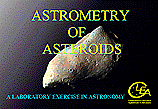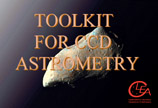
ASTROMETRY OF ASTEROIDS |
|||
|
|
|
Required Software
|
|
|
|
A Description of the Lab: |
|
|
|
|
Purpose: To introduce students to the techniques that astronomers use to discover asteroids and to measure their coordinates in the sky. To show students what is meant by parallax and how parallax is measured. This exercise incorporates software designed to find asteroids using digital images of the sky taken at different times, along with software designed to measure the precise positions of stars on images. It also includes several digital images of asteroids taken at research observatories and documentation for both the students and the instructor. In the first part of the exercise, students view pairs of images of the sky, align them so the stars overlap, and "blink" them to highlight moving objects...asteroids. Once an asteroid is identified, the software can display a chart of the star field around the asteroid by calling up positions of stars from a reference catalog (a selection of the Hubble Guide Star Catalog included with the software). By identifying at least three reference stars from the catalog with stars on the digital images, the software can then proceed to determine the astronomical coordinates of the asteroid (right ascension and declination) to a precision of about 0.1 seconds of arc. Measurements of the asteroid coordinates on several images taken at different time yields the angular speed of the asteroid. In the second part of the exercise, students analyze two images of
an the same asteroid taken at the same time from sites several thousand
kilometers apart ( A set of 10 optional image pairs is provided so that students can play "hunt the asteroid"; there are asteroids on only some of the image pairs. The trick is to find which images have asteroids, and to measure the positions of the asteroids. Other capabilities: CLEA's ASTROMETRY OF ASTEROIDS lab is capable of professional research results, although the software provided with the classroom exercise has its functions limited to those needed for simple exercises. A full-featured research version of CLEA's TOOLS
FOR ASTROMETRY is available with the capability of reading FITS and SBIG
images up to 2048 square (or greater, depending on available RAM), taking
input from the Guide Star and USNO Catalogs, ephemeris calculation and
plotting of finding charts, generation of IAU compatable reports, and a host
of other features. [AVAILABLE FOR WINDOWS ONLY] |

